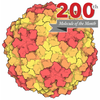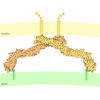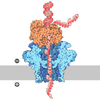+ Open data
Open data
- Basic information
Basic information
| Entry | Database: PDB / ID: 9no1 | ||||||
|---|---|---|---|---|---|---|---|
| Title | Cryo-ET map of the VZV capsid vertex (5-fold axis). | ||||||
 Components Components |
| ||||||
 Keywords Keywords | VIRUS / Varicella-zoster virus / capsid / cryo-ET / cryo-FIB | ||||||
| Function / homology |  Function and homology information Function and homology informationviral genome packaging / T=16 icosahedral viral capsid / deNEDDylase activity / viral tegument / viral capsid assembly / viral DNA genome replication / viral process / chromosome organization / viral penetration into host nucleus / viral capsid ...viral genome packaging / T=16 icosahedral viral capsid / deNEDDylase activity / viral tegument / viral capsid assembly / viral DNA genome replication / viral process / chromosome organization / viral penetration into host nucleus / viral capsid / host cell / symbiont-mediated perturbation of host ubiquitin-like protein modification / ubiquitinyl hydrolase 1 / host cell cytoplasm / cysteine-type deubiquitinase activity / Hydrolases; Acting on peptide bonds (peptidases); Cysteine endopeptidases / symbiont entry into host cell / host cell nucleus / structural molecule activity / proteolysis / DNA binding Similarity search - Function | ||||||
| Biological species |  Human alphaherpesvirus 3 (Varicella-zoster virus) Human alphaherpesvirus 3 (Varicella-zoster virus) | ||||||
| Method | ELECTRON MICROSCOPY / subtomogram averaging / cryo EM / Resolution: 8.3 Å | ||||||
 Authors Authors | Oliver, S.L. / Chen, M. | ||||||
| Funding support |  United States, 1items United States, 1items
| ||||||
 Citation Citation |  Journal: bioRxiv / Year: 2025 Journal: bioRxiv / Year: 2025Title: Cryogenic Electron Tomography Redefines Herpesvirus Capsid Assembly Intermediates Inside the Cell Nucleus. Authors: Stefan L Oliver / Muyuan Chen / Leeya Engel / Corey W Hecksel / Xueting Zhou / Michael F Schmid / Ann M Arvin / Wah Chiu Abstract: Herpesviruses encapsulate their double-stranded DNA (dsDNA) genomes within an icosahedral nucleocapsid formed in the infected cell nucleus. Four biochemically purified nucleocapsids have been ...Herpesviruses encapsulate their double-stranded DNA (dsDNA) genomes within an icosahedral nucleocapsid formed in the infected cell nucleus. Four biochemically purified nucleocapsids have been characterized, but their roles in herpesvirus replication remain controversial. The status of the capsid vertex-specific component (CVSC), essential for capsid stability and dsDNA packaging and retention, is also unclear. By integrating cryogenic focused ion beam milling with electron tomography and subtomogram averaging, we derived atomic models for all protein components, including the CVSC, across different herpesvirus capsid types within infected cell nuclei. Focused classification of pentonal vertex densities revealed differences in CVSC occupancy between genome-filled capsids and capsids lacking dsDNA, highlighting structural heterogeneity and providing insight into distinct capsid assembly stages . These intra-nuclear findings redefine the maturation model of herpesvirus capsid assembly, advancing the understanding of herpesvirus replication, and demonstrate the effectiveness of electron imaging by studying virus assembly within host cells. | ||||||
| History |
|
- Structure visualization
Structure visualization
| Structure viewer | Molecule:  Molmil Molmil Jmol/JSmol Jmol/JSmol |
|---|
- Downloads & links
Downloads & links
- Download
Download
| PDBx/mmCIF format |  9no1.cif.gz 9no1.cif.gz | 2.4 MB | Display |  PDBx/mmCIF format PDBx/mmCIF format |
|---|---|---|---|---|
| PDB format |  pdb9no1.ent.gz pdb9no1.ent.gz | Display |  PDB format PDB format | |
| PDBx/mmJSON format |  9no1.json.gz 9no1.json.gz | Tree view |  PDBx/mmJSON format PDBx/mmJSON format | |
| Others |  Other downloads Other downloads |
-Validation report
| Summary document |  9no1_validation.pdf.gz 9no1_validation.pdf.gz | 1.5 MB | Display |  wwPDB validaton report wwPDB validaton report |
|---|---|---|---|---|
| Full document |  9no1_full_validation.pdf.gz 9no1_full_validation.pdf.gz | 1.6 MB | Display | |
| Data in XML |  9no1_validation.xml.gz 9no1_validation.xml.gz | 302.2 KB | Display | |
| Data in CIF |  9no1_validation.cif.gz 9no1_validation.cif.gz | 468.6 KB | Display | |
| Arichive directory |  https://data.pdbj.org/pub/pdb/validation_reports/no/9no1 https://data.pdbj.org/pub/pdb/validation_reports/no/9no1 ftp://data.pdbj.org/pub/pdb/validation_reports/no/9no1 ftp://data.pdbj.org/pub/pdb/validation_reports/no/9no1 | HTTPS FTP |
-Related structure data
| Related structure data |  49591MC M: map data used to model this data C: citing same article ( |
|---|---|
| Similar structure data | Similarity search - Function & homology  F&H Search F&H Search |
- Links
Links
- Assembly
Assembly
| Deposited unit | 
|
|---|---|
| 1 |
|
- Components
Components
-Protein , 7 types, 24 molecules ABDFHJLCEGIKMNQOPRSTUVWX
| #1: Protein | Mass: 155145.359 Da / Num. of mol.: 7 / Source method: isolated from a natural source Source: (natural)  Human alphaherpesvirus 3 (Varicella-zoster virus) Human alphaherpesvirus 3 (Varicella-zoster virus)References: UniProt: Q4JQT5 #2: Protein | Mass: 24440.119 Da / Num. of mol.: 6 / Source method: isolated from a natural source Source: (natural)  Human alphaherpesvirus 3 (Varicella-zoster virus) Human alphaherpesvirus 3 (Varicella-zoster virus)References: UniProt: Q4JQV2 #3: Protein | Mass: 54028.180 Da / Num. of mol.: 2 / Source method: isolated from a natural source Source: (natural)  Human alphaherpesvirus 3 (Varicella-zoster virus) Human alphaherpesvirus 3 (Varicella-zoster virus)References: UniProt: Q4JQV5 #4: Protein | Mass: 34421.914 Da / Num. of mol.: 4 / Source method: isolated from a natural source Source: (natural)  Human alphaherpesvirus 3 (Varicella-zoster virus) Human alphaherpesvirus 3 (Varicella-zoster virus)References: UniProt: Q4JQT4 #5: Protein | | Mass: 73978.430 Da / Num. of mol.: 1 / Source method: isolated from a natural source Source: (natural)  Human alphaherpesvirus 3 (Varicella-zoster virus) Human alphaherpesvirus 3 (Varicella-zoster virus)References: UniProt: Q4JQT2 #6: Protein | Mass: 65253.941 Da / Num. of mol.: 2 / Source method: isolated from a natural source Source: (natural)  Human alphaherpesvirus 3 (Varicella-zoster virus) Human alphaherpesvirus 3 (Varicella-zoster virus)References: UniProt: Q4JQU1 #7: Protein | Mass: 306666.938 Da / Num. of mol.: 2 / Source method: isolated from a natural source Source: (natural)  Human alphaherpesvirus 3 (Varicella-zoster virus) Human alphaherpesvirus 3 (Varicella-zoster virus)References: UniProt: Q4JQX9, ubiquitinyl hydrolase 1, Hydrolases; Acting on peptide bonds (peptidases); Cysteine endopeptidases |
|---|
-Details
| Has protein modification | Y |
|---|
-Experimental details
-Experiment
| Experiment | Method: ELECTRON MICROSCOPY |
|---|---|
| EM experiment | Aggregation state: CELL / 3D reconstruction method: subtomogram averaging |
- Sample preparation
Sample preparation
| Component | Name: Human alphaherpesvirus 3 / Type: VIRUS / Entity ID: all / Source: RECOMBINANT |
|---|---|
| Molecular weight | Experimental value: NO |
| Source (natural) | Organism:  Human alphaherpesvirus 3 (Varicella-zoster virus) / Strain: pOka Human alphaherpesvirus 3 (Varicella-zoster virus) / Strain: pOka |
| Source (recombinant) | Organism:  Human alphaherpesvirus 3 (Varicella-zoster virus) / Strain: pOka / Cell: MeWo Human alphaherpesvirus 3 (Varicella-zoster virus) / Strain: pOka / Cell: MeWo |
| Details of virus | Empty: NO / Enveloped: YES / Isolate: SPECIES / Type: VIRION |
| Natural host | Organism: Homo sapiens |
| Virus shell | Name: Capsid / Diameter: 1250 nm / Triangulation number (T number): 16 |
| Buffer solution | pH: 7.4 |
| Specimen | Embedding applied: NO / Shadowing applied: NO / Staining applied: NO / Vitrification applied: YES |
| Vitrification | Cryogen name: ETHANE |
- Electron microscopy imaging
Electron microscopy imaging
| Experimental equipment |  Model: Titan Krios / Image courtesy: FEI Company |
|---|---|
| Microscopy | Model: TFS KRIOS |
| Electron gun | Electron source:  FIELD EMISSION GUN / Accelerating voltage: 300 kV / Illumination mode: FLOOD BEAM FIELD EMISSION GUN / Accelerating voltage: 300 kV / Illumination mode: FLOOD BEAM |
| Electron lens | Mode: BRIGHT FIELD / Nominal defocus max: 5000 nm / Nominal defocus min: 2000 nm / Cs: 2.7 mm |
| Image recording | Average exposure time: 0.974 sec. / Electron dose: 1.577 e/Å2 / Avg electron dose per subtomogram: 82.3 e/Å2 / Film or detector model: GATAN K3 (6k x 4k) |
| Image scans | Width: 5760 / Height: 4092 |
- Processing
Processing
| EM software | Name: EMAN2 / Category: CTF correction |
|---|---|
| CTF correction | Type: PHASE FLIPPING AND AMPLITUDE CORRECTION |
| Symmetry | Point symmetry: C5 (5 fold cyclic) |
| 3D reconstruction | Resolution: 8.3 Å / Resolution method: FSC 0.143 CUT-OFF / Num. of particles: 3804 / Symmetry type: POINT |
| EM volume selection | Num. of tomograms: 69 / Num. of volumes extracted: 3804 |
 Movie
Movie Controller
Controller



 PDBj
PDBj



